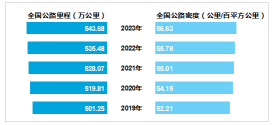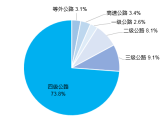I see a lot of posts like this now-a-days
I don't seem to get a reliable/trustable statistic about Chinese roadways, can anyone post some official stats about Chinese roadways length, types, investment etc.,
First, the Chinese government no longer publishes highway construction mileage separately but includes it as part of the annual Transportation Industry Development Statistical Bulletin. Therefore, searching for the 'Annual Transportation Industry Development Statistical Bulletin' of a specific year is more effective.
This statistical report primarily covers six main areas:
- Infrastructure (Highway mileage is included in this section, along with railways, water transport, and civil aviation, all falling under infrastructure statistics. )
- Transportation Equipment
- Transportation Services
- Traffic Fixed Asset Investment (In 2023, the total fixed asset investment in highways amounted to 2.824 trillion yuan, a decrease of 1.0% compared to the previous year. Specifically: Expressways: 1.5955 trillion yuan, down by 1.9% Ordinary national and provincial roads: 613.6 billion yuan, up by 1.0% Rural roads: 484.3 billion yuan, up by 0.7% Additionally, the 832 counties that have been lifted out of poverty completed a total of 718.3 billion yuan in highway fixed asset investment during the year. )
- Production Safety
- Scientific Innovation and Talent Team Building
Visit the official website of China’s Ministry of Transport. All the information you need is there, including data from the '
:
......
(2) Highway
By the end of the year, the total length of highways in China reached 5,436,800 kilometers, representing an increase of 82,000 kilometers from the previous year-end. The highway density stood at 56.63 kilometers per hundred square kilometers, with an increase of 0.85 kilometers per hundred square kilometers compared to the previous year.

Figure 2: National Highway Mileage and Density, Year-End 2019-2023
By the end of the year: The mileage of highways graded at level four or above was 5,270,100 kilometers, an increase of 107,600 kilometers from the previous year-end. This category accounted for 96.9% of the total highway mileage, up by 0.5 percentage points. The mileage of highways graded at level two or above was 762,200 kilometers, increasing by 18,600 kilometers, representing 14.0% of the total highway mileage, up by 0.1 percentage points. The expressway mileage was 183,600 kilometers, growing by 6,400 kilometers. Among these, national expressways covered 122,300 kilometers, with an increase of 2,400 kilometers.

Figure 3: Composition of National Highway Mileage at Year-End 2023 (by Technical Grade)
By the end of 2023: The mileage of national highways was 384,000 kilometers. The mileage of provincial highways was 404,100 kilometers. The mileage of rural roads was 4,598,600 kilometers, including: County roads: 696,700 kilometers Township roads: 1,242,800 kilometers Village roads: 2,659,100 kilometers.
It should be noted that:
(1) All the statistics mentioned only include roads that meet the national road construction standards for four grades of highways and expressways. Roads that do not conform to these standards, such as unclassified roads, unpaved roads, dirt roads, and gravel roads, are not included in the data.
(2) Expressway statistics are limited to fully operational, fully enclosed four-lane expressways that have been officially opened for traffic. (3) Urban streets, roads within enterprise projects, and roads used for agricultural and forestry production fall under the jurisdiction of the Ministry of Housing and Urban-Rural Development and are therefore not included in the statistics compiled by the Ministry of Transport.
(4) For sections of road where two or more highways overlap, the duplicate mileage is counted only once (for example, provincial or township roads that run parallel to expressways).
(5) Military roads are not included in the statistics.
Appendix:

- Expressways
- Fully controlled-access highways dedicated to motor vehicles for high-speed travel. They primarily connect important cities and regions, forming the backbone of the national highway network. Typically, they handle an average daily traffic volume of over 25,000 vehicles.
- First-Class Highways
- Designed for directional and lane-separated vehicle travel with partial access control and some grade-separated intersections. These highways mainly connect major political and economic centers and key industrial areas, serving as primary national trunk roads. A four-lane first-class highway can accommodate a future average daily traffic volume of 15,000 to 30,000 small passenger vehicles (converted from various types of vehicles); a six-lane highway can handle 25,000 to 55,000 vehicles.
- Second-Class Highways
- Trunk roads connecting important political and economic centers or busy suburban areas, suitable for various vehicles. They are designed to handle a future average daily traffic volume of 5,000to 15,000medium-sized trucks (converted from various types of vehicles).
- Third-Class Highways
- General trunk roads connecting towns at the county level and above, suitable for various vehicles. They are designed to handle a future average daily traffic volume of 2,000 to 6,000 medium-sized trucks (converted from various types of vehicles).
- Fourth-Class Highways
- Branch roads connecting counties, towns, and villages, suitable for various vehicles. They are designed to handle a future average daily traffic volume of:
- Dual-lane roads: up to 2,000vehicles
- Single-lane roads: up to 400vehicles (converted from various types of vehicles)
In summary, as of 2023, China's total highway mileage, excluding all roads not included in the official statistics, amounts to 5.43 million kilometers. This is less than India's total of 6.62 million kilometers, which ranks first in the world.
Jai Hind!
Personally, while it may seem counterintuitive at first glance that India has a longer road network than China, it no longer surprises me. Several years ago, domestic media in China extensively analyzed and reported on this phenomenon. Now, few people are surprised because we understand that the statistical methods and standards used by the two countries differ significantly, making direct comparisons unreliable.





